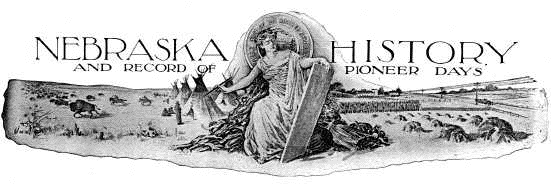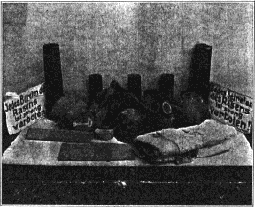|
DEATHS SINCE NOVEMBER
24
These obituaries are compiled largely from
death notices printed in newspapers which are received and
kept on file by the Historical Society. While the sketches
have been carefully edited, it has been impossible to avoid
and correct all inaccuracies. The lives of some subjects of
the obituaries were of unusual public interest, and in such
cases the sketches have been duly amplified. Statements of
fact, particularly those which are of record, have been
verified as far as practicable. Obviously, it is very
desirable that these records, which will always be used for
reference, should be correct, and surviving relatives and
editors of local newspapers should carefully cooperate in
preventing errors.
Mrs. John T. Van Buskirk died November 24, at
her home in Beatrice; was born July 22, 1847, in Wells
county, Ind.; came to Nebraska July 4, 1856, settling at
Nebraska City.
Mrs. Susannah Little, a resident of Gage
county since 1864, died November 25 at her home near
Beatrice, aged eighty seven years. She owned a farm on which
she had resided for nearly sixty years.
Mrs. Catherine Miller died at Seattle,
November 26, aged eighty one years; came to Lincoln county,
Nebraska. with her husband in 1860 and they started a road
house at a point east of Cottonwood Springs; moved to North
Platte in 1867.
Mrs. Marie Montgomery died December 2 at her
farm home near Firth, where she had resided forty three
years; born in Doylestown, Ohio, May 11, 1834; came to
Nebraska City in 1862, where she lived for thirteen years,
before moving to Firth.
Mrs. J. W. West, maiden name Malinda
Spurleck, died at Howe, Neb., Dec. 5, born May 20, 1823, in
the state of Alabama; came to Nemaha county, Nebraska, in
1852, and lived there until the time of her death.
Vaclav Kublicek died December 6 at his home
near Crete; born January 16, 1847, in Bohemia; came to
America in 1864, first to Chicago and after about six months
to Arago, Nebr.; then settled on a homestead near Crete, in
1865.
Mrs. Sarah Parks died December 28 at Red
Cloud; was born in Northamptonshire, England, July 14, 1832;
came to America, landing May 22, 1855; reached Salt Lake
City October 24 of the same year; four days after was
married to William Parks, to whom she had been previously
engaged; in 1859 they left Salt Lake City for Omaha with a
government train, escaping from Mormon surveillance; had
lived in Webster county about forty years.
Robert Alexander Wilson, born eighty six
years ago; died at Blue Springs on January 30. Mr. Wilson
came to the territory in 1866 and for a time was government
agent on the Otoe and Missouri Indian reservation near
Barneston, Neb. In 1861 he surveyed and platted the original
town site of Blue Springs.
Carl Gustaf Rosengren, born in Ephriam, Utah,
June 16, 1866, died January 21, near Colon: came to Fremont
with his parents in 1867.
John W. Pittman, born March 26, 1834, in
Harrison county, Indiana, died January 21, at his home near
Union; moved to Weston, Ia., in 1855, where he was a
storekeeper; came to Nebraska May 28, 1859, in debt from his
business venture, and took a preemption claim near Rock
Bluffs, but soon engaged in freighting across the plains
from Nebraska City on his own account; in 1867 settled
permanently on 160 acres of land in Liberty precinct, Cass
county, which he increased to a farm of over 600 acres;
married Miss Lydia A. Goodwin of Marion county, Iowa, and
they had nine children.
Willam Powell, born in Massillon, Ohio, March
19, 1843, died January 28 at Syracuse; came to Nebraska in
1857 with his parents, who settled in Johnson county; August
12, 1864, enlisted as corporal in Company A. First Regiment
Nebraska Veteran Volunteer Cavalry, from Fort Kearney;
mustered out May 28, 1866.
Thomas Long McNeil, born in New York City May
23, 1828, died about January 22, at Ogallala, where he had
lived many years; came to Nebraska in 1865 and settled on a
farm sixteen miles southwest of Lincoln; joined Lodge No.
19, A. F. & A. M. of Lincoln, on February 1, 1870, and
remained a member until his death.
Lewis Friel Cornutt, born in Grayson county,
Virginia, May 22, 1833, died January 11 at Nebraska City. He
left Virginia with friends in September 1854; traveled by
wagon and arrived at Nebraska City November 6 of the same
year. He soon went to Atchison county, Mo., but after a
short stay returned to Nebraska City; in 1860 moved to
Colorado; came back to Nebraska City in 1864; in the spring
of 1868 moved to Cheyenne, but again returned to Nebraska
City in 1871. He was mainly engaged in the merchintile (sic)
business in all of these places. though he also gave
attention to the development of gold mines at Central City,
Col., and to freighting at Nebraska City in 1868.
Andrew Christenson, born at Trelleborg,
Sweden, September 26, 1838, died January 12, at Malmo; came
to the United States in July, 1867, lived in Omaha until
1870, then settled on a homestead in Saunders County.
Mrs. Sallie M. Camp, born in the state of New
York June 9, 1832, died January 16 at Humboldt, came to
Nebraska in the spring of 1861 and settled near Auburn.
Mrs. Henry Jones, born in Prussia December 2,
1849, died January 18, at Wilber; came with her parents to
this country in 1867, who settled on a homestead in
Jefferson county, which Mrs. Jones owned to the time of her
death.
Benjamin Nathan Leisure, born in Indiana on
August 3,
|
in Pawnee City, December 28; came to Butler county in his
boyhood.
George W. Howe, born on a farm near North
Bend May 26, 1866, died December 31, 1918, at Fremont.
Daniel B. Colhapp, born in Covington, Ky.,
January 24, 1846, died January 2, at Tecumseh; when he was
nineteen years of age he became an apprentice in the
printing office of the Nebraska Advertiser which was started
at Brownville, June 7, 1856, by Dr. John McPherson and
Robert W. Furnas.
Mrs. Nancy A. Gessell, born at Lancaster
Ohio, December 27, 1834, died January 7, at Beatrice. She
was married in 1857 and lived at Odell, Neb., and later
moved to Beatrice.
Simpson McKibbin, born in County Down,
Ireland, in May, 1834, died January 10, at Emporia, Kan.;
emigrated to America in 1848; lived for a time in Grant
county, Wisconsin, next in Clayton county, Iowa; came to
Nebraska in 1864, settling in Hendricks precinct, Otoe
county, where he became a wealthy farmer; was married in
1860 to Miss Harriet M. Douglas of Mitchell county, Iowa,
who survives him. The town of Douglas was named for Mrs.
McKibbin.
Mrs. Peter Frederick, Sr., born July 22,
1838, at Delphos, Ohio, died January 11, at Falls City; came
to Richardson county in 1863 and had resided there ever
since.
MRS. WILLIAM NUTTER,
NEBRASKA PIONEER, 1859
Dinah Hingham was born in England in 1835;
married to William Nutter in 1855, they emigrated to
Philadelphia together in the same year, and thence to Salt
Lake City, via the Nebraska route, in 1859; in 1862 came to
Nebraska, squatting on a farm near Shelton, Buffalo county;
left in the panic caused by the general attacks on white
settlers by Indians in 1864 and returned to England, but
soon came back to Philadelphia and, in 1869, to Nebraska,
settling on a homestead near Gibbon, where Mrs. Nutter died
on December 31, 1918. Mr. Nutter died in 1908. That through
all this vicissitude this staunch couple had acquired and
developed one of the finest farms in Buffalo county and had
cared for their fifteen children, shows that the traditional
English heart of oak is not a myth and that they inherited
it. Furthermore, while, like many English folk at that time.
they were seduced by Mormon emissaries, they had the moral
courage to renounce and escape from this evil, un English
system.
DEATH OF A PROMINENT
NEBRASKA PIONEER
Thomas Swobe, who died at Berkeley, Calif.,
January 20, 1919 had a long and notable career in Nebraska.
He was born in Johnstown, Fulton county, N. Y., March 17,
1843; went to Niles, Mich., in 1857; October 16, 1861
enlisted as a private in Company E, Twelfth Regiment,
Michigan infantry Volunteers; reenlisted in the veteranized
regiment, February 4, 1863; was mustered out as first
lieutenant of Company K, March 6, 1866. He was on staff duty
about two years; quartermaster of the Second Division,
Seventh Army corps; post commissary at Washington, Ark., in
1865, and in December of that year was detailed as adjutant
general on Brevet Brigadier General May's staff, Southern
Division of Arkansas: came to Nebraska in August, 1866; was
employed in the city clerk's office for a year then became
secretary of the Central Land Company; elected city clerk of
Douglas county in 1869; elected councilman of Omaha in 1872
and in 1874; in 1876 engaged in the hotel and railroad
dining hall business with J. F. Markel; was one of six men
who built the Millard Hotel, in 1882, which was conducted by
himself and J. E, Markel until 1891, and afterward by
himself alone. In 1883 he became a member of the syndicate
which founded South Omaha and the Union Stock Yards Company
and brought the packing houses there, and was one of the
trustees of the site and their secretary; 1890, director of
the Omaha Driving Park Association; 1891, director of the
Real Estate Owners' Association of Omaha; 1892, member of
the council of Nebraska Commandery of the Military Order of
the Loyal Legion.
PIONEER
ASS0CIATIONS
The Old Settlers Historical Society of Howard
county is one of the most active in the state. Its
membership includes all persons who have lived in the county
thirty years or more.
At Home Rest Farm, near Murdock, the fiftieth
anniversary of the settlement of George Buell and George E.
Vanderburg was celebrated upon the homestead taken by Mr.
Buell fifty years ago.
Kearney county organized a county historical
society, April 10, with C. P. Anderberry president and Lee
A. Richmond secretary.
April 7 was the forty eighth anniversary of the
arrival at Gibbon of the Soldiers Free Homestead Colony.
Thirteen of the original colonists responded to the roll
call.
The Douglas County Association of Nebraska
Pioneers will hold its annual picnic in August this year,
and is making a campaign for a thousand new members, which
will bring its roll up to 3,000. Charles Unitt is president
and Mrs. Mary Cormack is secretary. These pioneers will miss
the face of David H. Mercer, former congressman, who was the
president last year.
_____________
A preliminary meeting was held on April 8 at the home of
Mr. and Mrs. C. P. Anderberry, Minden, to organize a county
historical society. A committee to draft a tentative
constitution and by laws was appointed, composed of Lee A.
Richmond, Mrs. J. A. Martin, C. P. Johnson and Mrs. R. W.
Walt. C. P. Anderberry was made temporary Chairman.
|

